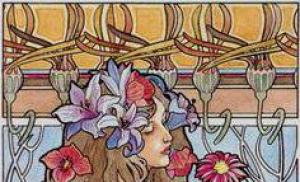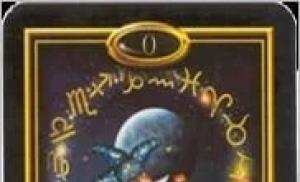Oak leaf with acorn Orthodox symbol. Oak is a mighty tree, a symbol of enormous vitality,...: mettiss — LiveJournal
- Aren’t you ever scared? - asked Alice.
- You are completely herealone, and no one is protecting you...
- How do you mean “alone”? - said Rose. - What about oak?
L. Carroll
“And the oak tree was once a crumb, a small acorn served as its cradle... There was no larger, more magnificent tree in the whole forest. Its top rose high above all the trees and was visible from the sea from afar, serving as a sign for sailors... Wood pigeons nested in the branches of the oak tree, the cuckoo crowed, and in the fall, when its leaves seemed forged from copper, other migratory birds perched on the branches..." - This is how Hans Christian Andersen describes this tree in his fairy tale “The Last Dream of the Old Oak.”
And this is a very revealing passage, because it presents almost the entire gamut of symbolic meanings and meanings that this forest giant acquired during the history of its existence on earth, namely longevity, the origin of the great from the small, splendor and power, a sacred significant place, protection and refuge , glory and even sacrifice. Let's take a closer look at them and consider them in detail.
Origin and etymology of the name
The Indo-European root of the word "oak" is identical to the root of the word "tree".
Holiness of the Oak
Many nations dedicated oak to the gods: Zeus among the Greeks, Jupiter among the Romans, Thor among the Germans, Perkunas among the Lithuanians, Oak God among the Japanese, Prove among the Baltic Slavs. And in Romov, the ancient Prussians sprinkled the sacred oak tree with the blood of sacrificial animals and worshiped three gods in its image.
Among the Lithuanians and Germans, the oak tree sometimes replaced the temple, because up to a hundred people could hide in its hollows.
The people of Palestine bury their prophets and saints under oak trees. Sufis do the same, who also decorate their branches with scraps of clothing.
In England, for a very long time it was believed that cutting down an oak tree was a fatal sin, although all other trees could be harvested without restrictions. It was used only for sacred fires. The oak was considered a tree that could heal and predict.
With the introduction of Christianity, the widespread destruction of oak trees began as the main object of pagan cults.
And only in the Renaissance did emblems associated with oak come into use again. Although sometimes oak leaves can be seen in Gothic ornaments.
And the legend is still alive according to which a skeptic who doubted the sanctity of an oak tree and cut off its branch lost his hand.
Oak is a symbol of longevity and power
Everywhere, oak is considered a symbol of longevity and power. And this is not surprising. After all, oaks have been known since ancient geological eras. These trees are contemporary with mammoths and other extinct animals. They can live up to 2.5 thousand years, and oak maturity occurs only at 150 years. Oak trees grow up to 30 meters in height and up to 25 meters in circumference. Until the 18th century, oak trees several hundred years old were common in Northern and Eastern Europe.

The symbolism of oak in Ancient Egypt
According to the Book of the Dead, the oak tree corresponds to the fifth hour of the night journey of the solar bark Ra.
The symbolism of the oak tree among the Celts
The Celts, like the Germans, revered oak trees on which mistletoe grew. They made human sacrifices under the oak tree.
The symbolism of the oak tree among the Druids
The name Druids itself probably comes from the word “dru” - oak.
In the Druid horoscope, March 21, the day of the vernal equinox, is dedicated to oak. In addition, the Druids ate acorns on the eve of predictions. They performed their services in oak groves.
The most sacred of the Druid rituals was the ritual of cutting mistletoe branches from an oak tree, which was considered a panacea for all diseases and misfortunes. It was made on a full moon. A druid in white robes sacrificed two white bulls to an oak tree, slaughtering them in the shade of the tree. Then a mistletoe branch was cut from the oak tree using a special golden sickle.
The symbolism of oak among the Slavs
The word oak itself in Slavic languages means “hollow tree” and for a long time the words oak and tree were considered synonymous. Moreover, oak was recognized as the main, real tree.
Oak in Rus' was also considered a symbol of protection and defense, and it was from oak that the walls of the Moscow Kremlin were built under Ivan Kalita.
The symbolism of oak in antiquity
In Ancient Greece, the oak tree was dedicated to Zeus the Thunderer. Perhaps this was because, according to observations, the oak tree was most often struck by lightning (this even became a proverb).
The Greeks believed that Zeus conveyed his will through the rustling of the leaves of the Dodona oak tree. His temples were decorated with oak branches and, perhaps, this is where the use of oak as a symbol of courage, valor, strength and power originates.
The famous club of Hercules was made of oak.
The Romans dedicated the oak tree to Jupiter. On the island of Nemi they revered an oak grove ruled by the forest king.
In addition, in antiquity, oak was considered the habitat of special nymphs - dryads (from the Greek drys - oak).
An oak wreath was considered a symbol of dignitary dignity among ancient Italian rulers.
Oak in Christian symbolism
In the Old Testament, under the shade of the Mamvrian oak tree, the Lord appeared to Abraham (under Emperor Costantine, a basilica was built on this site). Perhaps that is why, in the mysteries, God the Father often appeared under the name or in the form of an oak tree. Sacred oak trees surround Abel's tomb on the cliff of the Awaleh River in the Lebanese Mountains. Jacob buried all the idols of Sekhem under the oak tree. Joshua erected an oath stone under the oak tree. At Ophrah, the angel of the Lord appeared under the oak tree to Gideon. Rebecca's nurse was buried under an oak tree, later called the "weeping oak." Abimilech was made king at the oak tree. Saul was buried under the oak tree.
Later, oak, or more precisely holly (Ham oak), began to be considered one of those trees from which, according to legend, the cross of the Lord was made. The prickly holly is also a symbol of the crown of thorns. According to legend, when the trees heard that Christ was to be crucified, they agreed among themselves that they would not allow their wood to be used for this purpose and, when the woodcutter’s ax touched them, they fell into a thousand pieces. And only the holly remained intact. So this tree entered culture as a symbol of veneration of Christ, as well as a symbol of the passion of the Lord. In this meaning it can be seen in the images of St. Jerome (meditating on the passion of the Lord) and St. John (who proclaimed Christ the lamb of God and thus predicted his sacrifice). The fallen oak trunk, trampled under the foot of St. Boniface, is an allegory of the conversion of the pagans.

The symbolism of oak in astrology
In astrology, the oak tree corresponds to the zodiac sign of Leo.
Oak as an alchemical symbol
In alchemy, oak is teria, an oak tree that is hollow inside and means a barrel, a special vessel for fermentation and purification of elements. According to the Figures of Abraham the Jew, this is the sign of the smelting furnace.
Oak in military symbolism
The oak branch, oak wreath or garlands are used in military uniforms as emblems of valor and strength.
During the Nazi era, oak leaves were used as awards, honors and decorations.
Oak in heraldry
In Russian heraldry, the oak branch has been used since the end of the 19th century. On July 24, 1882, it was included in the large state emblem as the left side of the wreath, while the right branch was a laurel branch.
In Soviet heraldry, an oak branch and leaf were used as emblematic images on medals, orders, badges, monuments of military valor and coins issued in 1922-1991.
Oak leaves are included in the united emblem of the military organization of the Warsaw Pact countries.
In Germany, the oak leaf was used as an emblem from the Middle Ages until modern times. It was interpreted classically - as an emblem of valor, not only military, but also labor.

Color scheme in heraldic images of oak
The color of acorns is green, gold, brown, red or purple.
Leaf color is green, silver or gold.
(For more information about the meanings of specific colors, see the section “Color Symbolism”)
Signs and fortune telling related to oak
If oak leaves curl, it means drought (Wales).
Finding a worm in the acorn means poverty, and a spider means illness (England).
Take two acorns, name them after the lovers and place them in a bowl of water. If they get together while swimming, it’s a wedding (England).
To relieve a headache, drive a nail into an oak tree branch (Cornwall).
On the day of the summer solstice, you should silently rub a piece of oak with your hand and it will heal all your illnesses.
In Russia, oak was used to charm toothache, childhood illnesses, and throat problems.
Oak leaves were credited with the ability to bewitch and pacify lions.
Oak ash was considered to protect against bread rust.
Greek spellcasters believed that rain could be caused by using an oak branch.
An oak post in a dung heap was used to repel snakes.

Complex negative values
The more oak trees in the army, the stronger our defense.
If a boss constantly spreads his thoughts across a tree, then he is probably an oak tree.
He got his cerebral cortex from an oak tree.
The tables are oak, the oak trees are healthy.
No matter the boss is an oak tree, no matter the subordinate is a stump, no matter the paper is a linden tree.
You don’t often see people climbing an oak tree, but you often see people falling from an oak tree.
What kind of oak do you have to be to allow yourself to be skinned like a stick?
Life is like an acorn: you hang, sway, you don’t know when you’ll fall, you don’t know which pig will eat you, and all around you are oaks, oaks.
Each pig must build a barn, raise a piglet and plant an oak tree...
Where does such a rich complex of negative meanings, symbols and associations come from for such a noble tree?
As Ivetta Krasnogorskaya rightly notes in her article, perhaps in such situations people are repelled by the same inherently positive meanings that have grown into metaphors, such as “impenetrable” and “inflexible.”
Other meanings
An oak with acorns is an emblem of maturity, full of strength.
An oak without acorns is the emblem of young valor.
In German card games, the acorn is used as a suit symbol.
The acorn is a symbol of the male genital organ and is used in this meaning as an amulet.
For Walter Scott, the torn oak on Ivanhoe's shield meant loss of inheritance.

I would like to note that the oak leaf emblem is a truly timeless, classless and truly international symbol, closely associated with the concepts of courage, valor and honor.
However, even he did not escape the fate of “perverse” interpretation and inappropriate use.
This is how William Pokhlebkin describes in his book an amazing case when in 1986, during the restoration of the Yermolova House-Museum on Tversokoy Boulevard in Moscow, the portrait of the actress was placed in a wreath of oak leaves instead of laurel leaves. This was justified by the fact that since Yermolova is a Russian actress, the wreath could be from any Russian tree...
As the author rightly noted, if such an approach was established in the field of exact sciences, then chaos would await us, but “in the field of humanities we often find ourselves insensitive to manifestations of illiteracy” (V.V. Pokhlebkin. Dictionary of International Symbols and Emblems).
Concluding the conversation about one of the most magnificent symbols in human culture, I will again turn to Andersen’s fairy tale:
“The top of the oak tree swayed in a fit of melancholy, looking down... And then the green tops of the forest peeped through the clouds! The oak saw other trees below it... bushes and grass too. “No, how good it is, I just can’t believe it! - the old oak tree rejoiced. - They are all here with me, both small and large! Not one is forgotten! Is such bliss possible? “In heaven everything is possible!” - came in response” (G.H. Andersen. Fairy tales and stories).
So this tree becomes a symbol of the center of the world, its sacred axis, to which all other living beings in the universe are tied and followed, a prototype of a father who protects, leads and elevates a guide to a new level of cosmic perfection.
In many Indo-European traditions, there was a cult of the oak, which was considered a sacred tree, the home of the gods, the heavenly gate through which a deity could appear before people. Like all trees, the oak acts as a world tree: it symbolizes the world axis, connecting the upper and lower worlds, living beings and deceased ancestors, marking the center of the Universe. Oak meant strength, courage, endurance, longevity, fertility, nobility, and loyalty. This tree was dedicated to the supreme thunder gods: in Greece - Zeus, in Ancient Rome - Jupiter, in Germany - Donar, among the Lithuanians - Perkunas, among the Slavs - Perun.
Oak is symbolically associated with fire and lightning. According to J. Fraser, the ancients believed that “the great god of the sky, the object of their cult, whose terrible voice reached them in the peals of thunder, loved the oak above other forest trees and often descended on it from a thundercloud in the form of lightning, leaving in memory of his visit, a split, charred trunk and burnt foliage. Such trees were surrounded by a halo of glory, since their destruction was seen as the hand of the great Thunderer.” The place where lightning struck became sacred.
Oak groves were a place for rituals, the most important rituals (sacrifices, trials, oaths), and holidays were held in them. The oak club as a weapon of the thunderer or the sun god symbolized the firmness of power and severity. A wreath of oak leaves expressed the idea of strength, power, and dignity.
In Ancient Greece, the center of the sanctuary of Zeus in Dodona was an old oak tree, under which there was a spring. Based on the rustling of the leaves of this oak tree, the priests of the oracle at the temple made predictions. A special winged oak tree was also dedicated to Zeus, over which a blanket with images of the earth, ocean and stars was thrown. The gods Philemon and Baucis were posthumously transformed into oak and linden; here the oak acts as a symbol of marital happiness. The “oak” nymphs were dryads. In Athens, a boy who pronounced the marriage formula during the Eleusinian mysteries was crowned with oak leaves and thorns. According to legend, Hercules had an oak club. According to some versions, the mast of the Argonauts' ship was made of oak.
In Rome, oak symbolizes strength and longevity. Every year, the wedding of Jupiter and Juno was celebrated in the oak grove; the participants in the ceremony wore wreaths of oak leaves. Oak branches were carried in marriage processions as a symbol of fertility. An oak log was also considered sacred; it was used to maintain the eternal flame in the Temple of Vesta.
Oak played a significant role in the sacred beliefs of the Celts. In particular, Merlin works his magic under the oak tree. Celtic priests, Druids, turned oak groves into real sanctuaries and religious centers, and used oak branches in various ritual rites. The word “druid” itself comes, according to researchers, from the ancient name of oak. In Druid beliefs, the oak symbolized the axis of the world and was associated with strength and wisdom. According to the Celts, everything that grows on this sacred tree is a gift from heaven. A special role is played by the image of an oak tree entwined with the “golden branch” of mistletoe, with the oak symbolizing the male principle, and the mistletoe symbolizing the female principle. During the era of Christianization of the Celts, many churches and monasteries in Ireland were often built near oak forests or individual oak trees.
In the old days, the Slavs had a widespread belief that the souls of dead ancestors lived in oak trees. This idea is confirmed by the real fact of ancient burials in forests, in particular oak ones, on trees and under trees. In the legends and fairy tales of the ancient Slavs, the oak is often a sacred place with which the fate of a person is connected and near which events decisive for the heroes take place. The oak was also revered as a tree of fertility; The custom of planting an oak tree at the birth of a child has been preserved.
In the biblical tradition, oak is a symbol of pride and arrogance; Azimelach becomes king at the oak tree, Saul sits under the oak tree, Jacob buries foreign gods under the oak tree, Absalom meets his end at the oak tree. For Christians, the oak is the emblem of Christ as strength, manifested in trouble, firmness in faith and virtue. According to some versions of Christian tradition, the crucifixion cross was made of oak.
Many people think that oak leaves are all the same in nature. But that's not true. It is known that there are more than six hundred varieties of this tree found in different parts of the world. As for color, in summer the leaves can range from light and dark green to silver. Moreover, oaks growing on the Himalayan slopes have many differences from Scottish or tropical Polynesian ones, if only because in warm climatic latitudes they are evergreen plants that do not shed their leaves for the winter, as happens here.
However, all oak leaves are always wide, so some people confuse them with maple leaves, especially in the fall, when they turn into amazing variegated colors of all shades. Like most broadleafs, they have a thin plate, and intricate denticles are their characteristic feature. It is these denticles that distinguish these or other types of oak trees, as well as the presence or absence of fluff on the leaves and geometric features - they can be oval or elliptical in shape.

Places where these plants grow compactly are called oak groves. Oak leaves in spring on Russian territory appear quite late and are also the last to fall, trying to stay on the tree even in a dry state.
The tree grows slowly, at first actively stretching upward, because it cannot tolerate shading, which is why it strives with all its might for the sun. Only when it reaches a height that is advantageous to it does it begin to expand its trunk. Its root system is so powerful that this giant is not afraid of anything, which is why its lifespan is several centuries. So, in Russia alone, over the past two years, states have already received twenty-eight old-time oak trees that have lived from three hundred to five hundred years.

These giants are so amazing that since ancient times people have attached sacred significance to them and used oak leaves in many household rituals and healing recipes aimed at restoring strength, promoting health and maintaining beauty.
For the same reason, they were so actively used in heraldry by various tribes and peoples. The most famous example of this is the German principalities. The Germans at all times revered the oak leaf so much, the design of which was depicted on their coats of arms and shields in the Middle Ages, on awards and insignia in later times, that at the beginning of the Second World War they engraved it on the highest award - the knight's cross, which they were awarded the most valiant officers, and only with the representation of the Fuhrer himself.

Currently, according to the current legislation, if military personnel who have shown heroism are awarded the same award for the second, third, fourth time, then instead of the orders themselves they are given a breastplate with five degrees of valor - a silver oak leaf. The photo of these awards clearly demonstrates that each of the signs differs in size and is attached to. On it, the leaves are collected in a bunch along with stems and acorns.
Symbol meaning
Oak symbolizes strength and longevity, strength and hardness. Since time immemorial, the oak has been a sacred tree of many peoples: the Celts, the ancient Jews, the Greeks, the Romans. In the time of Abraham, near Shechem, there grew an oak tree of sorcerers or wise men, who interpreted the rustling of leaves and the cooing of doves in the branches as signs sent by the spirit of the tree. Under the sacred oak tree the Sibyl gave prophecies. The Druids performed their services in oak groves. For the ancient Greeks, the oak was the tree of Zeus. The famous club of Hercules was made of oak. The Romans considered oak to be the tree of Jupiter. The Temple of Baal, preserved in Damascus, was built in a grove of ancient oak trees.
Due to its enormous size and significant life expectancy, the oak in the mythology of many peoples was revered as the king of the forest, and therefore it was often dedicated to the supreme gods (Zeus, Jupiter, Perun, that is, the thunder gods: there was a belief that lightning strikes the oak most often) . An oak club is an attribute of the supreme or solar deities, symbolizing the firmness of power. Due to its close connection with the thunder god, oak is often associated with military themes; A garland of oak leaves is used in military emblems. A wreath of oak leaves symbolizes power and greatness.
Where can you find the symbol
 When to refer to a symbol
When to refer to a symbol
Contact the symbol so that every transaction you make will bring profit.
Techniques for activating a symbol
Tuning in to the symbol
Stand in the middle of the room and stare at the symbol for 2-3 minutes. Close your eyes and raise your arms up and slightly to the sides, relax your hands. Inhale, and as you exhale, shake your hands 3 times. Repeat 10 times.
The key phrase that opens the symbol's monetary energy
- Reliability and Strength lead to wealth!
Regular reference to the symbol Look at the image of the symbol for 10-15 seconds, then close your eyes, mentally imagining the symbol, try to hold the image for up to 20 seconds.
Open your eyes and look at it for another 10 seconds, repeating the affirmations:
- I am the best specialist in my field! 
- I get the joy of self-realization from work!
- I have an excellent income and financial independence!
Carry a picture of the symbol with you.
Ritual to enhance the effect of a symbol
Dry 5 oak leaves by smoothing them out. Place each sheet in a separate green envelope. Move the envelopes to the windowsill at night, and in the morning put them in a drawer on your desk. On the eve of concluding an important transaction, place envelopes between documents, take them out in the morning and hide them back in the table.
Plant themes in the art of body painting are usually divided into male and female. An oak tattoo is a symbol that has powerful masculine energy and personifies strength, courage, and endurance. This is one of the few drawings that does not have ambiguous and uncertain interpretations, and therefore is very popular. Who would suit such a tattoo, what does it tell about its owner?
What does the oak tree symbolize?
Oak is a powerful branching tree from the beech family with a well-developed root system. Its height can reach 60 meters, and the trunk diameter often exceeds 1.5–2 meters. Life expectancy is several thousand years, and sometimes there are specimens that are over 1000 years old. It is not surprising that our ancestors treated oak with special honor, considering it the king of trees. The Slavs associated him with strength and power and identified him with the supreme deity Perun. Acorns and oak branches were used as a talisman against evil spirits, leaving them at the entrance to the house. In Ancient Greece, a large tree was considered a statue of Zeus and was attributed to the thunder god. The oak symbolized longevity, physical strength and courage, so brave warriors were given an oak wreath as a reward. In ancient Rome, the acorn was called the fruit of Jupiter in honor of the god of the same name. During excavations, archaeologists discovered ancient statues, jewelry in the form of rings, and necklaces with images of trees.
The meaning of wood among different peoples
- the Gauls believed that the oak tree was the axis of the world
- among the French it symbolized hope and independence
- among the Celts - endurance and victory.
- The British identified acorns with antiquity and fertility.
It is noteworthy that Charles II, having lost the battle, was able to hide from his enemies in the oak tree. The tree is a heraldic symbol, so its image can be seen on the coats of arms of German, Latvian, Russian, Spanish cities and provinces.

Who is the tattoo suitable for?
The main meaning of the oak tattoo in the modern art of body painting is male strength and fertility, because it is from a tiny acorn that such a huge tree grows. The drawing is suitable for self-confident representatives of the stronger sex, hardy and brave, who want to emphasize their physical strength and power. Oak symbolizes immortality and longevity. It is believed that its image can prolong the life of its owner and activate internal energy.
By choosing such a drawing, a person, as it were, takes on the qualities inherent in this image.
The oak tattoo is also interpreted as a connection with ancestors, a return to origins, respect and veneration of one’s family. It was not for nothing that in the Middle Ages the tree symbolized noble origin. Images of acorns were embroidered on clothes by nobles and kings to emphasize their high social status and long-term reign. In modern tattoo art, a tattoo indicates not so much status as love for family, warm relationships with loved ones and relatives.
Despite the fact that the oak tree is a male symbol, girls can also choose oak leaves or acorns for their tattoo. The meaning of the picture remains unchanged - fertility, longevity, vital energy. In addition, it is believed that such a tattoo can attract wealth, material wealth, luck and success in endeavors, so the body decoration is also a talisman. Acorns with leaves will help develop creativity and achieve success in your career or study.

Execution technique
An oak tree tattoo in a graphic style looks impressive. A monochrome pattern is very suitable for men who want to focus on good physical shape and emphasize brutality. A similar effect is created in the dotwork style, where the image is applied using many small dots, due to which the tattoo becomes voluminous and convex. A sketch of an oak tree tattoo in the engraving style resembles an illustration from a medieval book. It is very important to clearly draw every detail so that the composition turns out to be as natural and effective as possible. To do this, you should apply a drawing on a large scale to the shoulder, back, arm, chest.
Representatives of the fair sex may consider the realism style. Tattoos with oak leaves will look beautiful on the forearm, shoulder blade, and wrist. And, of course, the palm belongs to the squirrel from the cartoon “Ice Age” hugging an acorn. This colorful character is well reproduced using the new school technique: this way the image turns out to be more cute and funny.
Video about the tattooing process
Photos of tattoos



























Selection of sketches


































